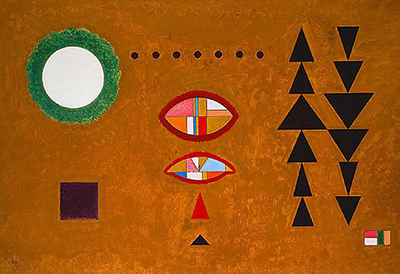Weiss-Weiss (White-White) is a Kandinsky painting from 1929. He produced it during his time living in Dessau, Germany.
The artist's famous abstract shapes are all present and correct. A plethora of triangles on the right hand side of the canvas are of varying widths, but uniform heights. It resembles a series of arrows, pointing in two different directions. These dark objects are separate from the rest of this composition, where overlapping is not used. This contrasts to many of Kandinsky's other works. The artist uses the same tone to create a square in the bottom left that also sits alone. One glancing at this piece might see an abstract form of a bathroom wall, with an elaborate mirror being found in the top left corner - this is not believed to have been in the artist's thinking.
The top left holds a white circle which is contained within an outline of green. The circle is precise, whilst the green floats like a gas around a planet. Kandinsky regularly jumped between precise lines and gradients of mass. The centre of the painting offers small, dark circles in a row across the top. There are then two objects which resemble an eye and a mouth, with further triangles placed underneath. These shapes are in red outlines, and a further complexity of shapes are then used to filled in their interiors. The background is a sort of mustard coloured mass which is deliberately vague and unobtrusive. In order to understand the meaning of his arrangement, we need to examine his other paintings from around this time as well as uncover any quotes that he may have made about the piece around that time.
This can be considered a lesser known painting from his career, with relatively little information being currently available in English. It is possible that greater detail can be uncovered by German speakers, perhaps even a quote from the artist himself that might shed a little more light on the original artwork as well as the theories and thinking behind it. For now, we can just enjoy it for its aesthetic value, whilst comparing it to other artworks from his career to perhaps make a few assumptions based on confirmed information found elsewhere.




